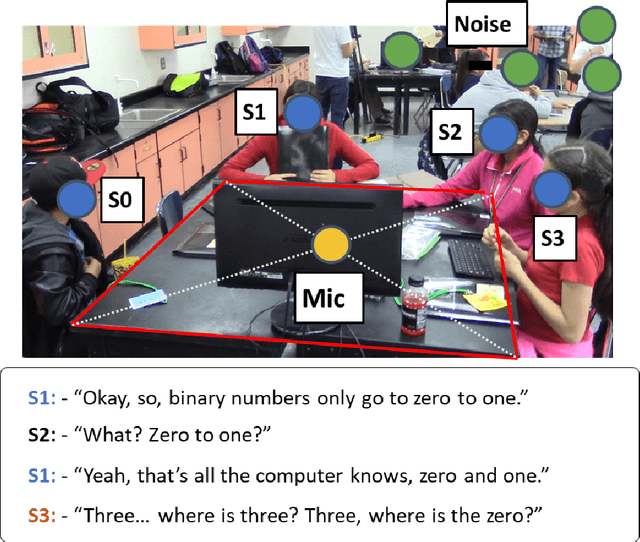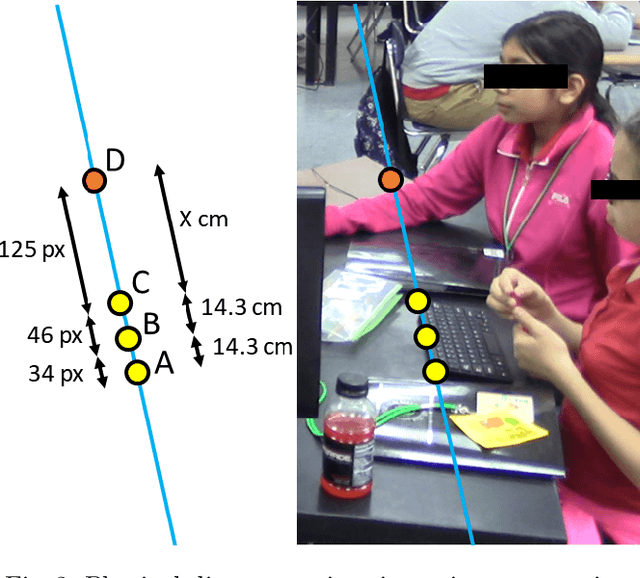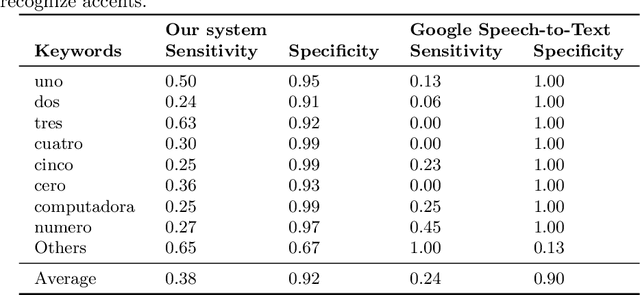Sylvia Celedón-Pattichis
Bilingual Speech Recognition by Estimating Speaker Geometry from Video Data
Dec 26, 2021



Abstract:Speech recognition is very challenging in student learning environments that are characterized by significant cross-talk and background noise. To address this problem, we present a bilingual speech recognition system that uses an interactive video analysis system to estimate the 3D speaker geometry for realistic audio simulations. We demonstrate the use of our system in generating a complex audio dataset that contains significant cross-talk and background noise that approximate real-life classroom recordings. We then test our proposed system with real-life recordings. In terms of the distance of the speakers from the microphone, our interactive video analysis system obtained a better average error rate of 10.83% compared to 33.12% for a baseline approach. Our proposed system gave an accuracy of 27.92% that is 1.5% better than Google Speech-to-text on the same dataset. In terms of 9 important keywords, our approach gave an average sensitivity of 38% compared to 24% for Google Speech-to-text, while both methods maintained high average specificity of 90% and 92%. On average, sensitivity improved from 24% to 38% for our proposed approach. On the other hand, specificity remained high for both methods (90% to 92%).
* 11 pages, 6 figures
Person Detection in Collaborative Group Learning Environments Using Multiple Representations
Dec 22, 2021



Abstract:We introduce the problem of detecting a group of students from classroom videos. The problem requires the detection of students from different angles and the separation of the group from other groups in long videos (one to one and a half hours). We use multiple image representations to solve the problem. We use FM components to separate each group from background groups, AM-FM components for detecting the back-of-the-head, and YOLO for face detection. We use classroom videos from four different groups to validate our approach. Our use of multiple representations is shown to be significantly more accurate than the use of YOLO alone.
Facial Recognition in Collaborative Learning Videos
Oct 25, 2021



Abstract:Face recognition in collaborative learning videos presents many challenges. In collaborative learning videos, students sit around a typical table at different positions to the recording camera, come and go, move around, get partially or fully occluded. Furthermore, the videos tend to be very long, requiring the development of fast and accurate methods. We develop a dynamic system of recognizing participants in collaborative learning systems. We address occlusion and recognition failures by using past information about the face detection history. We address the need for detecting faces from different poses and the need for speed by associating each participant with a collection of prototype faces computed through sampling or K-means clustering. Our results show that the proposed system is proven to be very fast and accurate. We also compare our system against a baseline system that uses InsightFace [2] and the original training video segments. We achieved an average accuracy of 86.2% compared to 70.8% for the baseline system. On average, our recognition rate was 28.1 times faster than the baseline system.
Talking Detection In Collaborative Learning Environments
Oct 14, 2021



Abstract:We study the problem of detecting talking activities in collaborative learning videos. Our approach uses head detection and projections of the log-magnitude of optical flow vectors to reduce the problem to a simple classification of small projection images without the need for training complex, 3-D activity classification systems. The small projection images are then easily classified using a simple majority vote of standard classifiers. For talking detection, our proposed approach is shown to significantly outperform single activity systems. We have an overall accuracy of 59% compared to 42% for Temporal Segment Network (TSN) and 45% for Convolutional 3D (C3D). In addition, our method is able to detect multiple talking instances from multiple speakers, while also detecting the speakers themselves.
 Add to Chrome
Add to Chrome Add to Firefox
Add to Firefox Add to Edge
Add to Edge